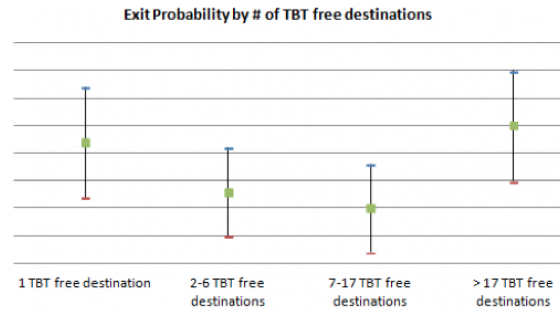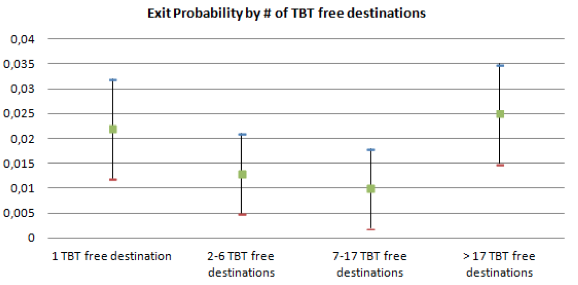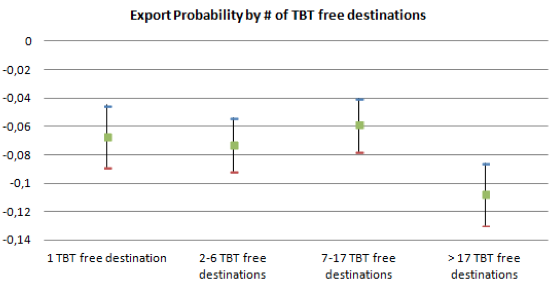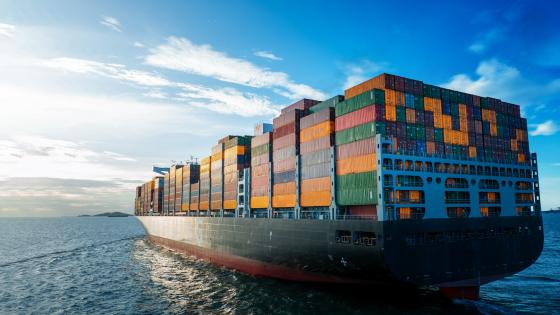Exporters are repeatedly confronted by mandatory regulations, standards, and procedures laying down product characteristics or their production methods, including the applicable administrative provisions on their foreign markets. Such technical requirements are introduced for health or safety purposes, to standardise products, to ensure quality standard, or to avoid consumer deception. Examples include maximum permitted levels of lead in paint used on toys, or emission requirements for diesel engines, or ‘cosmetic labelling’ (a requirement of describing the chemical composition in the label of personal hygiene products). Abstracting from their effect on the health of consumers, complying with these regulations de facto represents an increase in the cost of exporting into the country adopting the measures. The imposition of these regulations can raise the variable and/or fixed costs of exporting. Technical standards require the upgrading/adaptation of products or packaging (a variable cost) and sometimes a new product design, and the adaptation of the production chain (fixed costs). So, the imposition of a new ‘technical barrier to trade’ (TBT) might imply a reduction in the volume of exports (intensive margin channel) and/or discourage exporters from serving markets with TBTs (extensive margin channel).
A subset of TBTs is stringent enough to discourage exporters
Not all regulations and standards necessarily restrict trade however, as information is provided to foreign consumers on the unobservable characteristics of the imported products. This is why a multilateral agreement endorsed in 1994 by members of the WTO aims to introduce discipline – the TBT agreement negotiated during the Uruguay Round and extending the Tokyo Round ‘Standards Code’ (1979). Only a subset of technical measures raises obstacles high enough to justify a consultation in the dedicated committee in Geneva (in technical terms, a Specific Trade Concern at the TBT committee of the WTO).
The subset of TBTs challenged in the TBT committee thus provides a good laboratory to examine the impact of technical obstacles to trade on exporters’ behaviour. How big is the effect on the extensive/intensive margin of firm’s exports? Is this effect heterogeneous across firms with different characteristics? We ask these questions in a recent study, combining a panel of firm level export data with detailed information on the TBT concerns (Fontagné and Orefice 2016).
Firms of different size, product scope, or productivity will not be evenly affected by stringent TBTs. Small and low-productive exporters may have problems in overcoming the cost of adaptation to the new standard, and so exit the market. Meanwhile, firms with higher levels of productivity may comply with the new standard and enjoy the reduced competition in the market. Alternatively, big multi-destination exporters, enjoying a wide portfolio of markets, have the option of diverting shipments to other destinations and so may exit the market imposing the measure, and divert their sales towards TBT-free destinations (i.e. markets without those barriers).
The decision making is indeed complex. When a stringent technical standard is imposed in a destination market, exporting firms compare the cost of satisfying the standard to the cost of diverting shipments. The exporter must pay the fixed entry cost in a new destination (Baldwin and Forslid 2010) or an incremental cost for reaching marginal consumers in a market already served (Arkolakis 2010). The higher the cost of complying with the standard, the higher the probability that exporters will focus on other destinations. Multi-destination firms, having lower cost of diverting shipments, are expected to switch destination country more easily than other firms when a TBT is imposed.
Multi-destination exporters are more prone to exit TBT imposing markets
In a recent paper, we test these hypotheses using French firm level data over the period 1997-2007 (Fontagné and Orefice 2016). Using a sub-sample of TBTs that represent a consistent barrier to trade (Specific Trade Concerns raised at the TBT committee), we show that the imposition of stringent TBTs in the destination market induces the exit of exporters, with a magnified effect for exporters with a portfolio of markets that includes many destinations (multi-destination firms).
Coherently, in the presence of an active TBT concern, the probability of serving that market reduces by 7% for the average firm and by 11% for multi-destination firms (conditioned on firm size). A side effect of this selection is to increase the market share of incumbents. Some multi-destination firms that choose to remain in the market and comply with the TBT enjoy lower competition in that destination and increase exports by 16%. The presence of a TBT concern has no effect on the value of the average firm exports by destination (the intensive margin), suggesting that TBTs mostly represent increases in the fixed rather than variable export cost.
Figure 1 summarises the effect of TBT concerns on exit probability and export participation (the extensive margin) of French firms by the (quartile of) number of TBT-free destinations served by the firms in 1995. It clearly emerges that the presence of active TBT concerns increases the exit probability of firms and in particular of multi-destination firms (here defined as those with more than 17 TBT-free destinations, i.e. the 90th percentile in the number of destinations of firms). Coherently, multi-destination firms are less inclined than other firms to export to destinations with active TBT concerns. Given that multi-destination firms are the most productive (Bernard et al. 2011), the imposition of TBT has also negative welfare consequences for the imposing country in reducing the average productivity of incumbent firms.
Figure 1. The effect of TBT concerns on the extensive margin of firms
Source: Fontagné and Orefice (2016).
Note: Green squares are point estimates of the effect of TBT on exit and export probability by quartile of number of TBT-free destinations. Upper (lower) bound indicates confidential interval based on plus (minus) one standard deviation of coefficient.
In the presence of stringent TBTs, exporters balance the cost of complying with this regulation against the fixed cost of entering a new market, and make the decision to serve the new market if the regulation is stringent (as revealed by the existence of a STC). Our results in Fontagné and Orefice (2016) confirm that the presence of a stringent TBT causes exporters to bear the fixed cost of entering new markets (free of TBTs), with this effect magnified for multi-destination exporters. More productive exporters already serving several destinations are shown to be more likely to make the decision to enter a new market when confronted by TBTs in one of their current destinations.
Ultimately, stringent TBTs curb the aggregate trade elasticity
The presence of TBT concerns has also important consequences at the aggregated level. Stringent TBTs can affect total export and number of exporting firms in each sector-destination cell. In particular, TBTs are expected to reduce the number of exporting firms in each sector-destination cell, to a larger extent for sectors characterised by the presence of many multi-destination firms (since multi-destination firms are less prone to cope with TBTs). However, as predicted by Chaney (2008), the aggregate (negative) effect of TBTs on both total exports and number of exporting firms is magnified in homogeneous sectors (where more output is concentrated among small and less productive firms). These conjectures are confirmed by our results in Fontagné and Orefice (2016).
The strong negative effect of TBTs on aggregate export flows combined with the null effect on the intensive margin of individual exporters suggest that stringent TBTs result mostly in increases in fixed (rather than variable) trade costs. Moreover, the decomposition of the aggregate export elasticity to stringent TBT shows that about the 70% of the total effect of these barriers is channelled by the extensive margin channel.
References
Arkolakis, C (2010), “Market penetration costs and the new consumers margin in international trade”, Journal of Political Economy 118 (6), 1151- 1199.
Baldwin, R, and R Forslid (2010), “Trade Liberalization with Heterogeneous Firms”, Review of Development Economics, 14 (2), 161–176.
Bernard, A B, S J Redding, and P K Schott (2011), “Multiproduct Firms and Trade Liberalization”, The Quarterly Journal of Economics 126 (3), 1271 - 1318.
Chaney, T (2008), “Distorted gravity: the intensive and extensive margins of international trade”, American Economic Review 98 (4), 1707-1721.
Fontagné, L, and G Orefice (2016), “Let’s try next door: the Technical Barriers to Trade and Multi-destination firms”, CEPII Working Paper 2016-18.
WTO (2014), Technical Barriers to Trade, WTO, Geneva.





